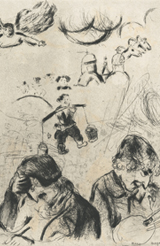
Marc Chagall had a long, fruitful and happy life in art. He belonged to those outstanding artists who do not fit within a definite style or artistic movement, neither belong to any national school, but create his own unique poetic style. Chagall worked in various fields of art - in painting, drawing, stained glass, sculpture and even tapestry. A very special and important area of his activity was book illustration. In nearly sixty years he created series of prints illustrating literary works My Life (1922-1923), Dead Souls by Nikolai Gogol (1927), Fables of La Fontaine (1930), The Bible (1931-1939 , 1952-1956), etc.). All these books were issued as limited editions, so-called livres d`art or livres de peintre. These books are printed on good paper, not stitched, decorated with original prints and bear the artist's autograph.
Dead Souls by Nikolai Gogol is one of these outstanding books. Illustrations fro the poem were commissioned to Chagall by a famous Parisian publisher and collector of art Amboise Vollard. Being in Berlin, Chagall received a letter from his longtime Paris friend, the poet Blaise Cendrars, who reported that Vollard, the leading Parisian marchand and publisher wanted to commission a series of illustrations for a great book and that for this commission he (Chagall) must come to Paris. "Come, you are famous here, and Vollard is waiting for you", Cendrars wrote to Chagall in 1922. In September 1923 Chagall arrived in French capital.
At the first meeting Vollard suggested – in his usual seriocomic way - to make illustrations for a story by Countess de Segur, General Durakin (Le general Dourakine, 1863), where Russian customs and morals were depicted rather mockingly. But Chagall insisted on Dead Souls. He always admired Gogol, in 1917 he produced a composition Hommage to Gogol, and in the very beginning of the 1920s created stage sets and costumes for The Inspector General of the State Jewish Theater in Moscow. Illustrations for Dead Souls were conceived and executed by Chagall in etching, or rather in the complex and volatile combination of different methods of engraving on metal, which he had just learned in Berlin – they were conventionally referred to as etching, but actually presented a mix of traditional linear etching with aquatint, dry point, mechanical treatment of the plate with roller, roulette and other instruments. The artist didn't always work within a complexity of engraving "cuisine" - he used as well the pure etching or dry point, and then he could combine these two methods with etching plus aquatint. By virtue of the creative techniques varying and applying suprising compositional structure, Chagall gained a very broad range of figurative means, thus producing striking artistic results.
He worked with a vehement - by the end of the same year 1924 about sixty etchings were produced, and in January 1926 Chagall reported that one hundred prints were made, so that his part of work was finished and it was Vollard’s turn to come to the point.
In 1927 the whole edition of the entire series of illustrations was printed. A small amount of prints remained in the free disposal of Vollard and Chagall himself, so they could be presented at the exhibitions, while the main part of the edition was deposited for book publishing; but for some reason, Vollard was not in a hurry to proceed with it (although, he used to act this way with regard of many projects). Despite the intention to print Dead Souls in the best French printing house Imptimerie National, Vollard continued to delay implementation of his own plan throughout 1930s and thus it was not carried out in the end (Vollard was killed in a car accident in July 1939). Then the World War II came, and only in 1947, twenty years after the prints were actually made, a prominent French publisher of the new generation Eugene Teriad was engaged in publication together with artist’s daughter Ida Chagall. The book was published in autumn 1948; it presented two ponderous volumes, not stitched, but enclosed in a case, with illustrations on inset sheets – and these were remaining prints made for the edition of 1927 (A. Rusakov. Marc Chagall as book illustrator. St. Petersburg., 2000, p.138-160).
Now we present these print illustrations in our virtual exhibition and want to introduce this very interesting and indeed essential part of Chagall‘s heritage to all who love his work.
